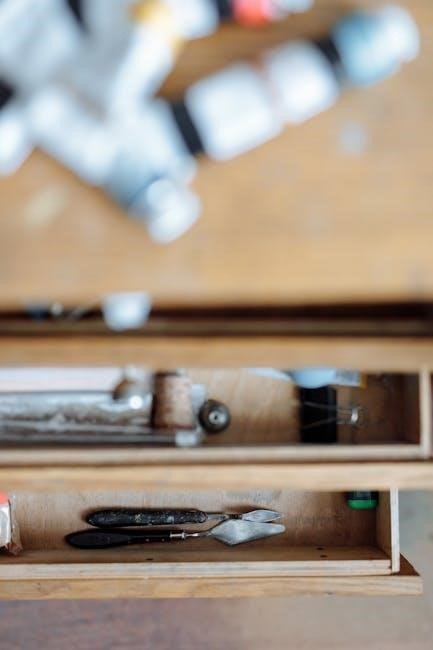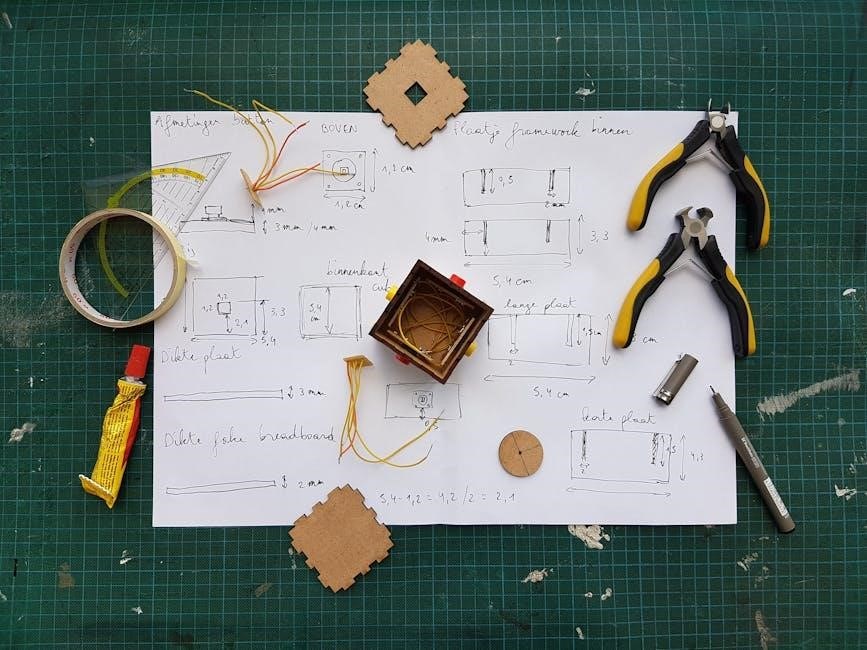Manual sausage makers are essential tools for home cooks and professionals, offering control over ingredients and texture for delicious homemade sausages. Perfect for all skill levels, they provide an enjoyable and rewarding cooking experience.
What is a Manual Sausage Maker?
A manual sausage maker is a kitchen tool designed to stuff ground meat into casings to create homemade sausages. Typically made of durable materials like stainless steel or food-grade plastic, these devices feature a cylindrical chamber, a piston, and stuffing tubes. They allow users to manually fill casings with precise control, making them ideal for small batches and traditional sausage-making. Compact, easy to use, and versatile, manual sausage makers are perfect for home cooks and enthusiasts seeking to customize their sausages.
Importance of Manual Sausage Makers in Home Cooking
Manual sausage makers empower home cooks to craft custom sausages with control over ingredients, ensuring healthier and tastier options. They preserve the art of traditional cooking, offering a fun and rewarding process. Ideal for small batches, they allow experimentation with flavors, fostering creativity in the kitchen. Their durability and ease of use make them a valuable addition for anyone seeking to elevate their culinary skills and enjoy homemade sausages year-round.

Key Features of Manual Sausage Makers
Manual sausage makers offer durability, versatility, and ease of use, with stainless steel construction, multiple capacity options, and interchangeable stuffing tubes for varied sausage creations.
Material and Durability
Manual sausage makers are crafted from durable materials like stainless steel, ensuring long-lasting performance and resistance to corrosion. Stainless steel models are easy to clean and sanitize, while plastic options offer lightweight convenience. High-quality materials ensure these tools withstand frequent use and maintain hygiene standards, making them reliable for homemade sausage making. Durable construction guarantees years of consistent performance, providing a worthwhile investment for culinary enthusiasts.
Capacity and Size Options
Manual sausage makers come in various capacities, ranging from compact 2-pound models for small batches to larger 22-pound units for commercial use. This versatility allows users to choose a size that fits their needs, ensuring efficient sausage making without waste. Whether for home cooks or professionals, the range of sizes accommodates different production scales, making these tools adaptable to diverse culinary requirements and preferences.
Stuffing Tubes and Versatility
Manual sausage makers often come with multiple stuffing tubes in different diameters, allowing users to create sausages of various sizes. This versatility enables the production of standard sausages, larger ones, and even specialized casings. The range of tubes caters to diverse recipes, from traditional links to gourmet varieties, making these tools ideal for both home cooks and professionals seeking customization in their sausage-making process.
Ease of Cleaning and Maintenance
Manual sausage makers are designed for easy cleaning and maintenance, with detachable parts that can be washed with warm water and detergent. Many models feature stainless steel components that resist corrosion and are simple to sanitize. Regular cleaning ensures hygiene and prevents residue buildup. Proper drying after washing helps maintain longevity, keeping your sausage maker in great condition for years of reliable use;
How to Choose the Right Manual Sausage Maker
Selecting the ideal manual sausage maker involves considering factors like capacity, durability, and ease of use. Choose models with stainless steel for longevity and simple cleaning.
Considering Your Sausage-Making Needs
When selecting a manual sausage maker, assess your needs: batch size, frequency of use, and desired batch size. Durable materials like stainless steel ensure longevity, while easy cleaning enhances convenience. For occasional use, compact models suffice, but heavy users may prefer larger capacities like 5LB or 22LB. Consider the number of stuffing tubes for versatility in sausage sizes. Manual models offer cost-effectiveness and control, ideal for both home cooks and professionals seeking precision.
Comparing Manual vs. Electric Sausage Makers
Manual sausage makers are ideal for small batches and traditionalists who value hands-on control, while electric models offer speed and efficiency for larger quantities. Manuals are cost-effective, portable, and require no power, making them perfect for home use. Electric sausage makers, however, handle big batches quickly, suitable for commercial settings or frequent sausage production. Choose based on your capacity needs, budget, and desired convenience for seamless sausage-making experiences.
Reading Reviews and Product Ratings
Reading reviews and product ratings is crucial when selecting a manual sausage maker. They provide insights into durability, ease of use, and cleaning. Look for models with high ratings, as they often highlight features like stainless steel construction, multiple stuffing tubes, and stability. Pay attention to user feedback on performance and value, ensuring the product meets your sausage-making needs and preferences for a satisfying cooking experience.

Step-by-Step Guide to Using a Manual Sausage Maker
Grind and season the meat, then soak casings in cold water to prepare for stuffing.
Attach the casing to the stuffing tube and ensure all parts are securely locked.
Fill the chamber with meat, press gently, and twist the filled casing to form links.
Cleaning Up
Disassemble and wash all parts with warm water and detergent for proper maintenance.
Preparing the Meat and Casings
Grind meat finely and mix with seasonings. Chill ingredients to prevent fat melting; Soak casings in cold water, then rinse and prepare according to type. For natural hog casings, soak longer and turn inside out to remove excess salt. Synthetic casings require shorter soaking. Tie one end of the casing securely before attaching to the sausage maker to ensure no filling leaks during the process.
Assembling the Sausage Maker
Attach the cylinder to the base and insert the plunger. Secure the desired stuffing tube to the end of the cylinder. Ensure all parts fit tightly to avoid air leaks. Some models come with suction cups or clamps for stability. If using a vertical stuffer, align the piston and cylinder properly. For horizontal stuffers, ensure the clips are tightened to hold the casing in place. Always follow the manufacturer’s assembly guide for specific instructions.
Filling and Linking Sausages
Attach the appropriate stuffing tube to the sausage maker. Fill the cylinder with seasoned meat, ensuring no air pockets. Slide casings onto the tube, leaving space at the end. Turn the handle to fill the casings evenly. Twist the filled casing into links to form individual sausages. For uniform links, pinch or twist at regular intervals. Manual control allows for precise filling and linking, ensuring perfectly shaped sausages with a traditional texture.

Tips for Making Perfect Sausages
Choose high-quality materials for durability and ease of cleaning. Use multiple stuffing tubes for versatile sausage sizes. Ensure consistent meat filling for uniform flavor and texture distribution.
Choosing the Right Meat and Seasonings
Selecting the right meat and seasonings is crucial for perfect sausages. Opt for fresh, high-quality meats like pork, beef, or chicken. Use precise seasoning measurements to avoid overpowering flavors. Classic spices include garlic, paprika, and black pepper. Experiment with herbs like parsley or oregano for unique profiles. Ensure meat is cold to prevent fat melting during grinding, maintaining texture. Balancing flavors and using fresh ingredients enhances sausage quality and taste; Consistency is key for delicious results every time.

Avoiding Common Mistakes in Sausage Making
Avoid overstuffing casings, as this can lead to bursting. Keep meat cold to prevent fat melting and ensure even grinding. Don’t skip seasoning the meat beforehand for balanced flavor. Avoid using low-quality ingredients, as they affect taste and texture. Ensure casings are properly prepared and not overfilled. Prevent air pockets by gently pressing meat during filling. Don’t rush the process—consistent, steady pressure yields better results. These tips help avoid common errors and ensure perfectly crafted sausages every time.
Maintenance and Cleaning of Manual Sausage Makers
Regular cleaning and maintenance ensure longevity. Disassemble parts, sanitize with warm water, and dry thoroughly. Lubricate moving components for smooth operation and to prevent rust formation over time.
Disassembling and Sanitizing Parts
Proper disassembly and sanitization are crucial for maintaining hygiene. Remove all detachable components, such as stuffing tubes and pistons, and wash them with warm soapy water. Sanitize using food-safe disinfectants or by soaking in hot water. Allow parts to air dry thoroughly to prevent moisture buildup and bacterial growth. Regular sanitization ensures food safety and extends the lifespan of your manual sausage maker.
Storage and Longevity Tips
To ensure longevity, store your manual sausage maker in a cool, dry place, away from direct sunlight. After cleaning, thoroughly dry all parts to prevent rust or bacterial growth. Use a protective cover or bag to shield from dust. Regularly inspect and maintain the device to ensure optimal performance. Proper storage and care will extend the lifespan of your manual sausage maker and keep it ready for future use.

Popular Models of Manual Sausage Makers
VEVOR, MZTOGR, and Usluole are top choices, known for durability, ease of use, and versatility. These models offer stainless steel construction, multiple stuffing tubes, and efficient sausage-making capabilities for home and professional use.
VEVOR Sausage Stuffer
The VEVOR Sausage Stuffer is a high-quality, stainless steel manual sausage maker with a 7LB/3L capacity. It features a two-speed operation for efficient filling and comes with four interchangeable stuffing tubes. The ergonomic design includes a short elbow and large suction cup for stability, minimizing meat waste. Durable and easy to clean, it’s ideal for both home and commercial use, ensuring safe and hygienic sausage making with food-grade materials.
MZTOGR Sausage Stuffer
The MZTOGR Sausage Stuffer is a durable manual sausage maker with a stainless steel body and horizontal design for stability. It includes eight stuffing tubes of varying sizes, allowing versatility in sausage and salami production. Easy to clean and operate, this stuffer is perfect for home and commercial use, ensuring efficient and consistent results with minimal effort and time required for each batch.
Usluole Sausage Stuffer
The Usluole Sausage Stuffer is a versatile manual sausage maker designed for easy use. Featuring a vertical stainless steel design, it offers a large capacity for making sausages efficiently. Equipped with four stuffing tubes, it allows for creating various sizes of sausages and salamis. Made from food-grade materials, it ensures safety and durability, making it an excellent choice for both household and professional kitchens, providing a convenient and effective sausage-making experience.

Safety Considerations
Handling sharp parts and ensuring hygiene are crucial when using manual sausage makers. Always sanitize components and store them properly to maintain food safety and prevent accidents.
Handling Sharp Parts and Meat Safely
When using a manual sausage maker, always handle sharp parts like blades and stuffing tubes with care to avoid cuts. Ensure meat is kept cold to prevent bacterial growth and wear food-grade gloves for hygiene. Sanitize all utensils and components before and after use to maintain cleanliness. Properly secure the sausage maker to prevent instability during operation, reducing the risk of accidents. Always follow safety guidelines to ensure a secure and hygienic sausage-making process.
Ensuring Hygiene and Food Safety
Proper hygiene is crucial when using a manual sausage maker. Always sanitize detachable parts with warm water and detergent. Regularly clean the machine to remove residual meat and prevent contamination. Store components in a dry place to avoid mold growth. Follow food safety guidelines to ensure all meat and casings are handled safely, maintaining the quality and freshness of your homemade sausages.
Manual sausage makers offer a rewarding way to create custom sausages, providing control over ingredients and texture. They are durable, easy to clean, and ideal for both home and professional use, making them a valuable addition to any kitchen.
Final Thoughts on Manual Sausage Makers
Manual sausage makers are versatile, durable, and easy to use, making them a must-have for home cooks and professionals. They offer control over ingredients and texture, allowing for custom sausages. With models like VEVOR, MZTOGR, and Usluole, there’s a stuffer for every need. They are easy to clean and maintain, ensuring longevity. Whether for small batches or large-scale production, manual sausage makers provide a rewarding and cost-effective way to enjoy homemade sausages with precision and creativity.